The items listed below are a representative sample of the bandoliers, harnesses, carriers, and other pieces of miscellaneous webbing that were designed to be slung over W.E., Patt. '37, but were not actually listed as part of this Pattern. There were many others, and as previously mentioned Karkee Web will be very pleased to list any and all other examples that may be supplied by our readers.
Stores Ref. A1/AA 5332 Bandolier, Sten gun, Pattern A
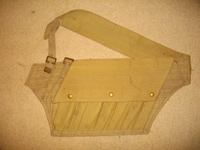

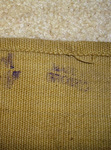 The example at left is the earlier form of Sten bandolier, known as “Pattern A”, which utilised a single flap over all seven magazine pockets. The striated form of webbing is typical of Australian manufacture, which is actually where this example was found. The press fasteners are of “civilian” origin. The construction was more complex than necessary, rather wasteful of material and a single flap, with only three press fasteners, was not the cleverest idea. Also not so clever, a Didcot official photo annotates this variant with the code A1/ AA 5332, the same as Pattern B. Presumably, a decision had yet to be made on which design to use, so a single code was all that was ever allocated. This example is marked "MADE BY GROSBY", who were a footwear manufacturer and still are in Australia, owned by The Pacific Dunlop Group. From the Graham Gough Collection. Photographs © Graham Gough, 2013.
The example at left is the earlier form of Sten bandolier, known as “Pattern A”, which utilised a single flap over all seven magazine pockets. The striated form of webbing is typical of Australian manufacture, which is actually where this example was found. The press fasteners are of “civilian” origin. The construction was more complex than necessary, rather wasteful of material and a single flap, with only three press fasteners, was not the cleverest idea. Also not so clever, a Didcot official photo annotates this variant with the code A1/ AA 5332, the same as Pattern B. Presumably, a decision had yet to be made on which design to use, so a single code was all that was ever allocated. This example is marked "MADE BY GROSBY", who were a footwear manufacturer and still are in Australia, owned by The Pacific Dunlop Group. From the Graham Gough Collection. Photographs © Graham Gough, 2013.

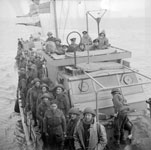
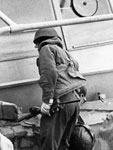
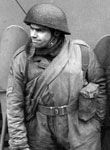 Several writers have stated that this design was used on Operation Biting, the Combined Ops raid on the Bruneval Radar Station in February 1942 (far right), but until now we've seen no photographic evidence to support this. See http://en.wikipedia.org/wiki/Operation_Biting. We are therefore grateful to to receive a photo from the collection of Nicholas Bucourt (left), which clearly shows the broad fabric shoulder strap. In addition, two IWM photographs have been located (near right), from which these crops have been made. These show the troops returning from the Raid.
Several writers have stated that this design was used on Operation Biting, the Combined Ops raid on the Bruneval Radar Station in February 1942 (far right), but until now we've seen no photographic evidence to support this. See http://en.wikipedia.org/wiki/Operation_Biting. We are therefore grateful to to receive a photo from the collection of Nicholas Bucourt (left), which clearly shows the broad fabric shoulder strap. In addition, two IWM photographs have been located (near right), from which these crops have been made. These show the troops returning from the Raid.
Stores Ref. A1/AA 5332 Bandolier, Sten gun, Pattern B
Stores Ref. A1/AA 5332 Bandolier, Sten gun
Stores Ref. A4/AD 0065 Bandolier, Sten gun
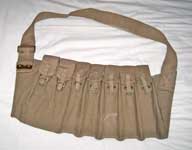
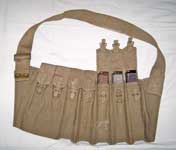
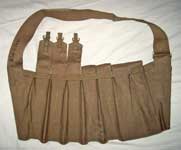 The use of Pattern A and B suggests that the designs were possibly produced in parallel, perhaps as trials items, but intended for Airborne troops. Pattern A was evidently abandoned, in favour of the more sensible construction of Pattern B. The earliest example seen is dated 1942, with the latest being 1944. It was coded originally in the general infantry series of wartime 5000 codes. Towards the end of the war, the existing Section A was expanded beyond A2, up to A6. The 1948 V.A,O.S, Section A4 Airborne Equipment shows the Bandolier now coded correctly. It was still in the 1960 edition of A4.
The use of Pattern A and B suggests that the designs were possibly produced in parallel, perhaps as trials items, but intended for Airborne troops. Pattern A was evidently abandoned, in favour of the more sensible construction of Pattern B. The earliest example seen is dated 1942, with the latest being 1944. It was coded originally in the general infantry series of wartime 5000 codes. Towards the end of the war, the existing Section A was expanded beyond A2, up to A6. The 1948 V.A,O.S, Section A4 Airborne Equipment shows the Bandolier now coded correctly. It was still in the 1960 edition of A4.
The quality of manufacture shows that it was not a “throw-away” article. A large piece of medium webbing was folded in half, cut to an inverted rhomboidal shape and stitched together, forming seven narrow vertical pockets between the folds. The top edges are turned inwards and stitched into a hem. Viewed from the front, an adjustable 2-in. wide thick web shoulder strap was attached at an angle to the top right-hand corner. A 2-in. three bar buckle, chape and fixed runner were attached to the opposite corner. Each pocket, containing one Sten magazine, was closed by the standard style of MECo pointed flap secured by a Q.R. fastener.
This form of fastener, used as a simple (and cheap) alternative to press fasteners, appears on late production Basic pouches and also the V.G.O. pouches. It is constructed from 0.5-in. thin web and two blanked brass components. The Link is attached to the under side of the flap (or lid) by a piece of doubled thin web. A second piece is doubled and partially stitched to make a stiff tab, with the un-stitched part forming a “pull tab”. The Staple is a square of brass wire, with the turned ends bent out to form “legs”. When stitched to the front of the pocket (or pouch) the legs keep the staple perpendicular to the body of the pocket. The Link is placed over the Staple and the stiffened tab pushed through it. Though it was simple, it was awkward to use, especially when the tab got dog-eared with use. Despite this the Q.R. fastener endured until Pn. ’90 P.L.C.E. was introduced. Only with Pn. ’58 was an improvement made, with flexible steel strip being sandwiched between the doubled material of the tab.
As the sling is short, it only allows a high carriage, above belt level, so that the term “Bandolier” is appropriate. In my experience, few wartime photographs depict the Bandolier and no post war photographs at all. All examples so far seen are in mint, un-issued condition, suggesting that many saw no use at all. This example is maker marked "M." and dated 1944. It is from the Chris Pollendine Collection, photographs © Chris Pollendine 2009.
Stores Ref. unknown Carrier, Case, binocular, Patt. ’37 W.E.
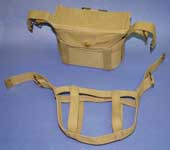 This nomenclature has to be read with care! It is not a Patt. ’37 W.E. component, but is simply a device used to carry a Patt. ’37 W.E. item. As a piece of wartime design, it is a classic example of how not to do something! Civilian binocular cases always had a shoulder strap and, for whatever reason, it was decided to make a Carrier to provide this facility. Perhaps it had left officers at a disadvantage at point-to-points, race meetings and maybe even manoeuvres! The logic was that not all binocular users wore complete sets of Patt. ’37 W.E. This example is from the Ed Storey Collection, photograph © Ed Storey 2007.
This nomenclature has to be read with care! It is not a Patt. ’37 W.E. component, but is simply a device used to carry a Patt. ’37 W.E. item. As a piece of wartime design, it is a classic example of how not to do something! Civilian binocular cases always had a shoulder strap and, for whatever reason, it was decided to make a Carrier to provide this facility. Perhaps it had left officers at a disadvantage at point-to-points, race meetings and maybe even manoeuvres! The logic was that not all binocular users wore complete sets of Patt. ’37 W.E. This example is from the Ed Storey Collection, photograph © Ed Storey 2007.
The Carrier, was introduced by L. of C. §B4510, in 1941, the nomenclature being misleading. It would have been better if it had been Carrier, W.E. Patt. ’37 Case, binocular. The waste of manufacturing capacity, making this complex Carrier, seems finally to have sparked some lateral thought. A.C.I. 580/1941 announced a modification for the Case itself, described in Officers' Equipment page, whereby 1-inch buckles and chapes were to be riveted to the sides of the Binocular case. Rather obvious in the first place, I would have thought!
Map Cases
Map cases have been relocated to their own Map Cases sub-section in the Non-Patterned Equipment, Technical Equipment, Survey section.
Stores Ref. A1/AA 5900 Harness, carrying, infantry
Stores Ref. CN 1023 Harness, carrying, infantry
Stores Ref. 8465-99-976-6256 Harness, carrying infantry
This item has been relocated to its own Harness, Carrying, Infantry page in the the Non-Pattern Equipment, Bulk Load Carriage section.
Bandolier, cotton, 50 rounds. (Mark I.)
Bandolier, cotton, 50 rounds. (Mark I*.).
Stores Ref. Q2/QB 0090 Bandolier, cotton, 50 rounds. (Mark II.)
Stores Ref. Q2/QB 0090 Bandolier, cotton, 50 rounds, Mark II.
Stores Ref. Q2/QB 0090 Bandolier, cotton, 50 rounds, Mk. 2
Stores Ref. Q2/QB 4947 Bandolier, cotton, 50 rounds, Mk. 3
Stores Ref. Q2/QB t.b.d. Bandolier, cotton, 50 rounds, Mk. 3/1
This item was catalogued in Section 27 of the Priced Vocabulary Of Stores (P.V.O.S.), a Section which did not exist until after 1915. It is also not known if Marks I and I* had stores codes, as these were only introduced between the Wars.
They appear slung over one, or both shoulders, in almost every photograph taken in the field, both in the First and Second World Wars. Despite its simplicity, it is worth looking at the item in greater depth. Aside from the Rifle sling, which dates from 1901, it was the oldest design of “accoutrement” still in service. Not only oldest then, but decades later, ammunition for the S.L.R. came in this type of bandolier. Later still, the bandolier for S.A.80 ammunition continued the principle, albeit in nylon. Harking back to the turn of the century, they have even returned to the use of small press studs. This simple bandolier, in its various forms, has given over a century of service to date and the origins are also worth examining. The Patt. ’14 Pouch, ammunition, 60 rounds was specifically designed to contain a folded Cotton bandolier.

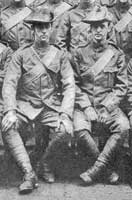 During the South African War 1899-1902, the Mills Woven Cartridge Belt Company of London, England (predecessor to M.E. Co.), had supplied woven - not stitched Lightweight Bandoliers, containing 100 rounds. The drawing at right is taken from the MWCB Co. patent. They were packed in ammunition boxes and the bandoliers were intended only for ease of carriage from box to soldier. The photo at left shows members of the 2nd City of London Rifles (10th V.B. Kings Royal Rifle Corps) wearing Mills Company Lightweight Bandoliers. Unfortunately, these bandoliers, intended for one-time use, were pressed into service as part of Mounted Infantry equipment. Being lightweight, they stretched, ammunition was lost and complaints were filed. This also brought the heavier webbing bandoliers into disrepute. Although it affected the Mills Company's reputation at the time, the Lightweight Bandolier did spawn a very successful product – the Bandolier, cotton, 50 rounds. This entered service in 1906, though it was not actually manufactured by M.E. Co..
During the South African War 1899-1902, the Mills Woven Cartridge Belt Company of London, England (predecessor to M.E. Co.), had supplied woven - not stitched Lightweight Bandoliers, containing 100 rounds. The drawing at right is taken from the MWCB Co. patent. They were packed in ammunition boxes and the bandoliers were intended only for ease of carriage from box to soldier. The photo at left shows members of the 2nd City of London Rifles (10th V.B. Kings Royal Rifle Corps) wearing Mills Company Lightweight Bandoliers. Unfortunately, these bandoliers, intended for one-time use, were pressed into service as part of Mounted Infantry equipment. Being lightweight, they stretched, ammunition was lost and complaints were filed. This also brought the heavier webbing bandoliers into disrepute. Although it affected the Mills Company's reputation at the time, the Lightweight Bandolier did spawn a very successful product – the Bandolier, cotton, 50 rounds. This entered service in 1906, though it was not actually manufactured by M.E. Co..
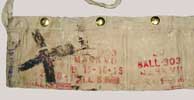
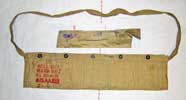 The Basic pouches of Patt. ’37 W.E. were intended to hold Bren magazines, but also Cotton bandoliers, with which empty Bren magazines would be refilled by the infantry Section members. The bandolier’s design had advanced through Mark I., Mark I*, the early Mark II was introduced by L. of C. §15627, approved on various dates between 1910 and 1911. It consisted of a length of “…khaki coloured jean…” doubled lengthways and stitched by double lines into 5 pockets, the top edges of which were hemmed to double thickness. As with the Mks. I and I*, the pockets were closed by “…push spring buttons…”. These are actually very small items and other early examples have been noted with (a) large, smooth press fasteners, like the Canadian United Carr type and (b) with pressed metal buttons, working in button holes. It is not yet known if these relate to specifically Mark I or I* bandoliers, as L. of C.s prior to 15627 have yet to be located.The WW I vintage Mk. II example shown left has the type (a) press fasteners. It is from the Les Butler Collection, photo © Les Butler 2009. At right is another WW I vintage Mk. II. This one uses the type (b) zinc uniform buttons. Interestingly, both of these bandoliers are maker marked "W.S.T. & Co. Ltd." and both are dated 1915.
The Basic pouches of Patt. ’37 W.E. were intended to hold Bren magazines, but also Cotton bandoliers, with which empty Bren magazines would be refilled by the infantry Section members. The bandolier’s design had advanced through Mark I., Mark I*, the early Mark II was introduced by L. of C. §15627, approved on various dates between 1910 and 1911. It consisted of a length of “…khaki coloured jean…” doubled lengthways and stitched by double lines into 5 pockets, the top edges of which were hemmed to double thickness. As with the Mks. I and I*, the pockets were closed by “…push spring buttons…”. These are actually very small items and other early examples have been noted with (a) large, smooth press fasteners, like the Canadian United Carr type and (b) with pressed metal buttons, working in button holes. It is not yet known if these relate to specifically Mark I or I* bandoliers, as L. of C.s prior to 15627 have yet to be located.The WW I vintage Mk. II example shown left has the type (a) press fasteners. It is from the Les Butler Collection, photo © Les Butler 2009. At right is another WW I vintage Mk. II. This one uses the type (b) zinc uniform buttons. Interestingly, both of these bandoliers are maker marked "W.S.T. & Co. Ltd." and both are dated 1915.
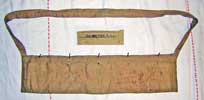 Other than 15627, no other L. of C. was referred to in L. of C. §23310. However, later supplies of the Mark II had evidently exchanged the press studs for small hooks, in the style of dressmaker’s hooks. The change was approved on 13th June and 18th July 1916, but it was only announced in L. of C. §A3067 - eleven years later!! New manufacture of the bandoliers would be with hooks, but older examples, when repaired, would continue to have the spring button type. These were made of doubled copper wire, the doubled “point” of which was simply pushed through a hole in the material and bent over. Each pocket contained two chargers of 5 rounds, the one with bullets “points up”, the other “points down”. A length of the same material was doubled and stitched to a 1 1/8-in. width and stitched to each top corner. There was no adjustment to this shoulder sling, which was 34 1/2-in. long. The late 1st War Mk. II example shown left is maker marked "D.A. Unter" and dated May 1918. Interestingly, it has hooks made of thin copper sheet, rather than wire as stated in A 3067. In addition to this 1918 dated example, the Karkee Web Collection also includes Mk. II bandoliers dated 1921 and 1929 (and both from yet another manufacturer). These also sport copper sheet hooks instead of the wire ones specified by the L. of C. and shown on the 1940 bandolier pictured below.
Other than 15627, no other L. of C. was referred to in L. of C. §23310. However, later supplies of the Mark II had evidently exchanged the press studs for small hooks, in the style of dressmaker’s hooks. The change was approved on 13th June and 18th July 1916, but it was only announced in L. of C. §A3067 - eleven years later!! New manufacture of the bandoliers would be with hooks, but older examples, when repaired, would continue to have the spring button type. These were made of doubled copper wire, the doubled “point” of which was simply pushed through a hole in the material and bent over. Each pocket contained two chargers of 5 rounds, the one with bullets “points up”, the other “points down”. A length of the same material was doubled and stitched to a 1 1/8-in. width and stitched to each top corner. There was no adjustment to this shoulder sling, which was 34 1/2-in. long. The late 1st War Mk. II example shown left is maker marked "D.A. Unter" and dated May 1918. Interestingly, it has hooks made of thin copper sheet, rather than wire as stated in A 3067. In addition to this 1918 dated example, the Karkee Web Collection also includes Mk. II bandoliers dated 1921 and 1929 (and both from yet another manufacturer). These also sport copper sheet hooks instead of the wire ones specified by the L. of C. and shown on the 1940 bandolier pictured below.
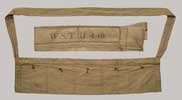 A further L. of C., §A8412, approved 20th March 1934, concerned only the R.A.F., where both bandoliers and ammunition boxes were made obsolete. It is thought this was in connection with the R.A.F. surrendering their rifles to the Army. There were instead to receive an un-specified and then non-existent automatic rifle! By the time L. of C. §B2045 was issued, approved 9th and 29th March 1938, the bandolier had moved from P.V.O.S.. Section 27 to V.A.O.S. Section Q2 S.A.A. and M.G. Ammunition, Shell Fuzes, Tubes, Primers, Fireworks (non explosives) and empty packages. This 1940 example of a Mark II, by an un-identified maker, “W.S.T.” is marked “II”, and was filled in April 1940. From the John Bodsworth Collection, photo © J. Bodsworth 2009.
A further L. of C., §A8412, approved 20th March 1934, concerned only the R.A.F., where both bandoliers and ammunition boxes were made obsolete. It is thought this was in connection with the R.A.F. surrendering their rifles to the Army. There were instead to receive an un-specified and then non-existent automatic rifle! By the time L. of C. §B2045 was issued, approved 9th and 29th March 1938, the bandolier had moved from P.V.O.S.. Section 27 to V.A.O.S. Section Q2 S.A.A. and M.G. Ammunition, Shell Fuzes, Tubes, Primers, Fireworks (non explosives) and empty packages. This 1940 example of a Mark II, by an un-identified maker, “W.S.T.” is marked “II”, and was filled in April 1940. From the John Bodsworth Collection, photo © J. Bodsworth 2009.
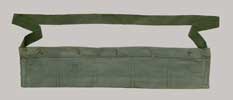
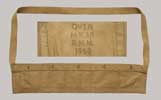 L. of C. §C491, approved 4th Sept,1944 and 22nd Jan, 1945, introduced the Mark 3 and made the Mk. 2 (a change from “II”) obsolescent. The new pattern was made from “…stronger cotton drill…”. Although the L. of C. makes no mention, the sling was also changed to one made from 11/8-in. wide, thin, herring-bone twilled webbing. In the 1950’s the Mk. 3/1 appeared, made in both khaki and dark green cotton drill and with an extra strip of strengthening material doubled round the outside bottom edge. L. of C. §D274, approved 19th Dec 1962 and 19th June 1964 made the Marks 2 and 3 obsolete. Shown right are two examples of the Mk. 3/1. The khaki bandolier is maker marked "R.M.M." and dated 1960. The green example is maker marked "W" and is undated. Both are from the John Bodsworth Collection, photographs © J. Bodsworth 2009.
L. of C. §C491, approved 4th Sept,1944 and 22nd Jan, 1945, introduced the Mark 3 and made the Mk. 2 (a change from “II”) obsolescent. The new pattern was made from “…stronger cotton drill…”. Although the L. of C. makes no mention, the sling was also changed to one made from 11/8-in. wide, thin, herring-bone twilled webbing. In the 1950’s the Mk. 3/1 appeared, made in both khaki and dark green cotton drill and with an extra strip of strengthening material doubled round the outside bottom edge. L. of C. §D274, approved 19th Dec 1962 and 19th June 1964 made the Marks 2 and 3 obsolete. Shown right are two examples of the Mk. 3/1. The khaki bandolier is maker marked "R.M.M." and dated 1960. The green example is maker marked "W" and is undated. Both are from the John Bodsworth Collection, photographs © J. Bodsworth 2009.
The design continued to serve for 7.62 mm S.L.R. ammunition, without either modification, or advance in mark number. A similar bandolier, once again fitted with press studs, caters for the current S.A. 80 Rifle. The sample so far examined is small, statistically speaking. KW would welcome further information and photographs of examples, with their markings.
The terms “jean” and “drill” beg questions, which leave little by way of confirmation – one way, or the other! The Oxford English Reference Dictionary states :-
“Drill A coarse twilled cotton or linen fabric”.
“Jean A heavy twilled cotton cloth, especially denim”.
“Twill A fabric so woven as to have a surface of diagonal parallel ridges”.
The bandoliers were packed in tens (500 rounds) into airtight metal cases, having soldered-on lids, which were of “rip-off” design, with a large wire handle to facilitate this. This “liner” was placed in a plywood box, closed by a ply lid held on by “knock-off” clamps. The box had two wire handles, with a metal connecting piece/handle for comfort and is often seen being carried in the field. The same box type was used for ammunition in cardboard cartons of 32 separate rounds. Finally two boxes (1000 rounds) were placed, side-by-side, in a steel ammunition box for bulk transit.
Stores Ref. A1/AA 0651 Case, pistol, signal
Stores Ref. B2/AA 0651 Case, pistol, signal
Stores Ref. B1 1095-99-961-9509 Case, pistol, signal



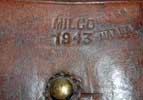 Edward Wilson Very (1847 -1910) was an American who had served in the U.S. Navy, rising to Admiral. He invented the eponymous pistol for projecting the coloured flares he had developed. The British Army does not seem to have made much use of it until the Great War. Amongst other manufacturers, many examples noted were made by Webley & Scott, the gun makers. Although seen in photographs, no holster seems to have existed, until the Case, pistol, signal was introduced by L. of C. §23704, approved on 12th May 1920. Although the L. of C. is worded “New Pattern”, no reference is made to any previous pattern being made obsolescent, or obsolete. This seems to confirm no ready means of carrying the Very pistol had been provided previously.
Edward Wilson Very (1847 -1910) was an American who had served in the U.S. Navy, rising to Admiral. He invented the eponymous pistol for projecting the coloured flares he had developed. The British Army does not seem to have made much use of it until the Great War. Amongst other manufacturers, many examples noted were made by Webley & Scott, the gun makers. Although seen in photographs, no holster seems to have existed, until the Case, pistol, signal was introduced by L. of C. §23704, approved on 12th May 1920. Although the L. of C. is worded “New Pattern”, no reference is made to any previous pattern being made obsolescent, or obsolete. This seems to confirm no ready means of carrying the Very pistol had been provided previously.
At this time No. 1 Very pistols had short brass barrels, with a bell-mouthed brass extension to this. Though these auxiliary barrels were often removed, the holster body was made wide enough to accommodate them. The butts of the No. 1 series (which reached Mark V), were curved like old-fashioned flintlock pistols The Nos. 2 and 3 models of pistol were shorter, with parallel sided barrels (in steel) and butts derived from the Webley .38-in. Revolver. These would all fit into the Case, pistol, signal. The No. 4 pistol, was for aircraft use, having bayonet style lugs, as it was designed to lock onto a port in the fuselage roof.



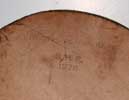 All examples of U.K. manufacture so far encountered are leather, ranging from the Second World War to NATO coded examples, made exactly the same way. In style they are all “Sam Browne” in shape, but with dimensions suitable for the Very Pistol, which used 1 inch cartridges. The body was butt-stitched, with the muzzle cap box-stitched. The example shown above left is marked MILCO 1943. The N.S.N. coded example (left), marked B.H.E. 1976, has been simplified, the edges of the body stitched flat, the muzzle cap still being box-stitched. An adjustable, 1-inch shoulder sling is stitched permanently to the edges of the 1943 Case, with a large, half-standing and inverted belt loop below. Because of the flat stitched edge on the NSN coded example, the rear end of the sling has to be stitched to the rear of the holster. The flaps have a 1 inch wide tab, the cut end doubled under and stitched, which is unusual in leather securing tabs. The tab is eyeletted and fastens to a brass stud, let into the front of the holster. The brass single roller buckle for adjustment of the sling dictated carriage on the right side, i.e. buckle on the chest.
All examples of U.K. manufacture so far encountered are leather, ranging from the Second World War to NATO coded examples, made exactly the same way. In style they are all “Sam Browne” in shape, but with dimensions suitable for the Very Pistol, which used 1 inch cartridges. The body was butt-stitched, with the muzzle cap box-stitched. The example shown above left is marked MILCO 1943. The N.S.N. coded example (left), marked B.H.E. 1976, has been simplified, the edges of the body stitched flat, the muzzle cap still being box-stitched. An adjustable, 1-inch shoulder sling is stitched permanently to the edges of the 1943 Case, with a large, half-standing and inverted belt loop below. Because of the flat stitched edge on the NSN coded example, the rear end of the sling has to be stitched to the rear of the holster. The flaps have a 1 inch wide tab, the cut end doubled under and stitched, which is unusual in leather securing tabs. The tab is eyeletted and fastens to a brass stud, let into the front of the holster. The brass single roller buckle for adjustment of the sling dictated carriage on the right side, i.e. buckle on the chest.



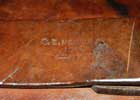 The above examples are of all-stitched construction, but an all-riveted example is also illustrated (left). The use of rivets is often a feature of Naval leather accoutrements and the style of this example is reminiscent of Patt. 1901 Naval Accoutrements. The edges of the body are overlapped and riveted through. Where Army examples have an inset leather piece, closing off the muzzle section, this has 9 segmented “fingers”, which are riveted to an internal piece of leather. The arrangements of sling, belt loop and closure tab are otherwise as the 1943 example above, though the sling is stitched on, not riveted. Marked S.E. NORRIS & CO 1940 LIMITED, there is no Broad Arrow and N that would denote Naval ownership and its provenance was an Army store.
The above examples are of all-stitched construction, but an all-riveted example is also illustrated (left). The use of rivets is often a feature of Naval leather accoutrements and the style of this example is reminiscent of Patt. 1901 Naval Accoutrements. The edges of the body are overlapped and riveted through. Where Army examples have an inset leather piece, closing off the muzzle section, this has 9 segmented “fingers”, which are riveted to an internal piece of leather. The arrangements of sling, belt loop and closure tab are otherwise as the 1943 example above, though the sling is stitched on, not riveted. Marked S.E. NORRIS & CO 1940 LIMITED, there is no Broad Arrow and N that would denote Naval ownership and its provenance was an Army store.
A.C.I. 36/1944 transferred the holster from V.A.O.S. Section A1 to B2 Small Arms Accessories, Tools and Packages, where a “long bracket” took a line too much, as it’s next to B1. The 1976 example is prefixed, correctly, in Section B1 Small Arms and their components. L. of C. §C416 applies (A1 to B1, not B2, plus the Pt 3 entry in L. of C.).
No corresponding Pouch for the cartridges has ever been noted.
No webbing equivalent is known within the U.K. Armed Forces, the webbing examples being peculiar to Canada and will be illustrated when Empire coverage is added. All photos from Rog Dennis Collection. © R.J. Dennis 2009